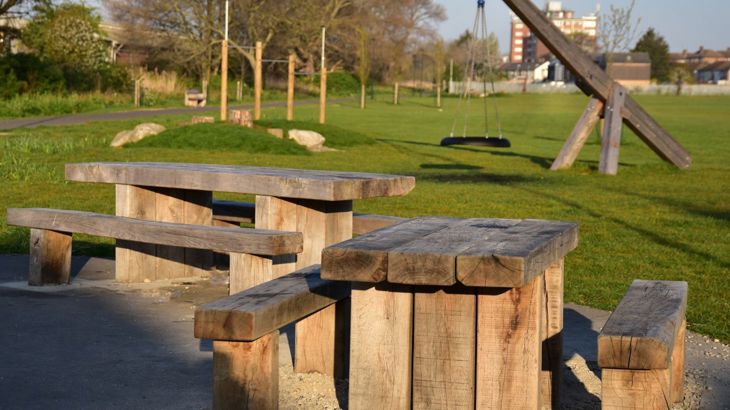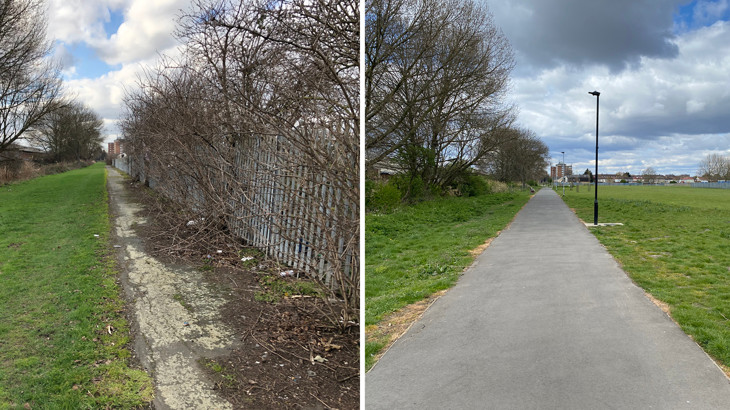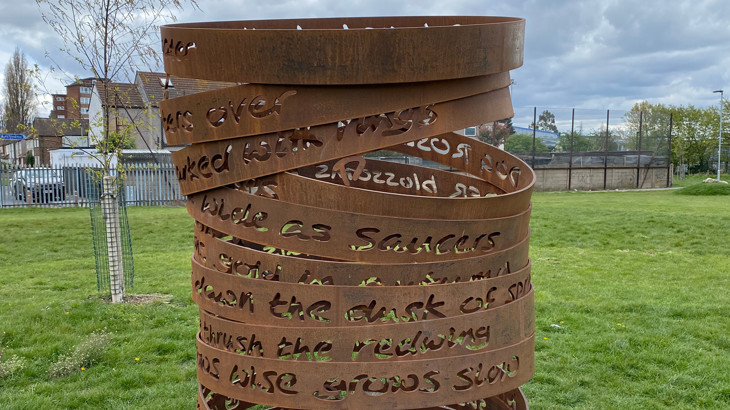We worked in partnership with the London Borough of Barking and Dagenham and the Greater London Authority to reimagine the Ripple Greenway. We have now created a beautiful linear park that is benefiting the residents in this growing part of east London.

©2021, Paul Scott, all rights reserved. We have created a 1.3km linear park that provides a green route to school and work, for thousands of people in Barking and Dagenham.

This project was awarded the 2022 Chartered Institution of Highways and Transportation (CIHT) award for 'Creating Better Places'.
It is vital that local councils provide good quality, safe green space for the physical and mental health of local residents in our towns and cities.
We need to create environments where it is a pleasure to get out and about on foot, in a wheelchair, with a pushchair or on a cycle.
Transforming a forgotten green space into a thriving park
We have created a new 1.3km linear park that provides a green route to school and work, for thousands of people in Barking and Dagenham.
It is a safer, healthier alternative to the busy and polluted Thames Road nearby.
And it creates a green link between the heart of the existing community and the new communities in the emerging Barking Riverside housing development.
Residents in the new housing will be able to access existing facilities including a doctor's surgery, library, shopping parade and primary school.
Existing residents will be able to benefit from new facilities, including the new Overground Station, Barking Riverside, and a secondary school, Riverside Academy.
Take a bird's eye view of the Ripple Greenway and listen to Robert Macfarlane read the poem he wrote to celebrate this new linear park in Barking.
Success through partnership
To create the park the community wanted, we worked closely with a diverse range of partners to make the project a success.
What we did
We wanted to come up with a project that would meet the needs of the residents. Here are the five phases of our work:
1. Scope
Set project goals and how they were to be achieved.
Informed local people about the project and invited as many people as possible to tell us their views about the green space.
2. Discover
To understand how we could make the park accessible to everyone and meet the diverse needs of the residents, we:
Established a stakeholder management group made up of representatives from each community group. This was responsible for steering the project to best meet diverse local needs.
Held coffee mornings at schools, nurseries and community centres to understand the needs of parents and families.
Conducted disability audits, organised workshops for stakeholders and schools.
We also had drop-in sessions where residents could come and discuss their ideas and views with us at their convenience.
Developed a variety of communications tools to help residents keep up to date on the project.
Surveys, leaflets, telephone contact details, design workshops and family events on the playing fields were all.
We wanted to do all we could, to hear from those who are often ignored in the planning process to tell us their aspirations for the area.
3. Co-design
Drawing on all our research, our team of designers created a concept design.
Popular themes that were important to local people included:
- removing a spiked metal fence
- introducing a simple tarmac path to make it easier to walk, wheel and cycle
- removing barriers
- adding benches for people to stop and rest along the way
- building play features for children.
We wanted to make sure that Ripple Greenway would feel like a safe and fun route to school and accessible to disabled users.
With Living Streets, we led walking audits with local school children and residents. We also asked Barking and Dagenham’s Access group to guide us through the area.
4. Test
We held exhibitions of designs developed at the co-design stage for further feedback.
We also trialed a scheme. To find out what people thought of the potential design of their park, we conducted a survey both online and in person.
5. Deliver
The concept designs were an integral part of our successful bid to the Greater London Authority.
We secured £440,000 from the Mayor of London’s Green Capital grant.
Regeneration specialists for the London Borough of Barking and Dagenham, Be First, also provided £350,000 to enable the borough to deliver this ambitious project for its residents.
Our suggested designs for the borough were based on the feedback that residents had given us.
We also provided officers with data analysis from our monitoring and our recommendations for the next steps.

The left photo shows what the area looked like, and on the right is how the route looks now that we have reimagined the space and transformed it into a greenway.
Taking our lead from the community
The creation of this park always had the community at its heart.
With their guidance we:
- Put in a wide and accessible tarmac path, suitable for wheelchair users, walkers, runners, people cycling and people pushing prams.
- Introduced seating for people to stop, rest and enjoy the space.
- Added lighting so people feel safer travelling through the park in the dark. Children are able to use the park as a route to school all through the year, even in the winter months.
- Planted native trees and spring bulbs to enhance the natural beauty of the park and increase local biodiversity.
- Collaborated with renowned artists to design bespoke artwork and wayfinding.
- Designed play-on-the-way features to encourage children and families to come and enjoy this public green space.

©2021, Paul Scott, all rights reserved.
Increasing biodiversity
One of the concerns residents came to us with was the potential negative impact the work would have on wildlife.
With Trees for Cities, replaced metal fencing that ran along a concrete flood retention channel with rich wetland habitat and naturalised beaches.
New decked viewpoints and pathways now improve pedestrian access so more people can enjoy wildlife and feel connected to nature on their doorstep.
Flood protection the natural way
A significant benefit of this wetland restoration is the long-term improvement of nature-based flood resilience in the area.
Tree planting
With Trees for Cities, we ran community tree-planting events, introducing more than 100 large native trees and thousands of daffodils and other spring bulbs.
Taking beautiful art to where people live
We partnered with the renowned poet Robert Macfarlane and sculptor Katy Hallett to create bold nature-inspired wayfinding features.
Poetry
Robert wrote a bespoke poem about the new plants in the Ripple Greenway and those that were already growing wild. His poem was cut into corten steel.
It guides people through the park and the different plants visible along the way.
Sculptures
Drawing inspiration from Robert’s book of Lost Words, Katy chose names of plants and animals that were recently removed from the Oxford Junior Dictionary and created corten steel sculptures.

An exemplar in public realm design
We hope this wildlife restoration and habitat creation will set a benchmark for sustainable and nature-based public realm design in London.
With thanks to our partners:
- Greater London Authority
- London Borough of Barking and Dagenham
- Local residents
- London Borough of Barking and Dagenham Access Group
- University of East London’s ecology department
- Barking and Riverside Housing Association
- Alexandra Steed URBAN
- Trees for Cities
- Renowned poet, Robert Macfarlane
- Award-winning sculptor, Katie Hallett
- Thames View Infant School
- Thames View Junior School
- George Carey Primary School
- Residents’ associations
- Mums on a Mission
- Thames View Muslim Association
- Thames View Community Garden.
If you would like more detail on this project, please email us at CollaborativeDesign@sustrans.org.uk.
Additional information
Plans to link new cycleways to Ripple.
Planting design by Trees for Cities.





